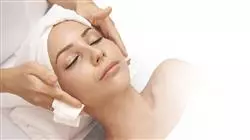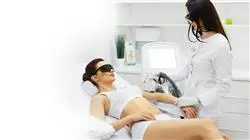University certificate
Scientific endorser

The world's largest faculty of nursing”
Introduction to the Program
A comprehensive, 100% online program, available exclusively through TECH with the backing of the National League for Nursing"

In today's society, where appearance plays a decisive role, skincare has evolved from being merely an aesthetic concern to a reflection of well-being and health. In this context, aesthetic medicine has rapidly evolved, incorporating new techniques, products, and approaches that require highly skilled professionals. The demand for experts in this field has grown not only in clinics and specialized centers but also in hospital settings and private practices, where aesthetic care is combined with dermatological and therapeutic treatments.
In this context, aesthetic medicine has rapidly evolved, incorporating new techniques, products, and approaches that require highly skilled professionals.
Aware of this transformation, TECH has developed the Masters Degree in Aesthetic Nursing, designed to provide healthcare professionals with comprehensive knowledge of the skin, its characteristics, and the most innovative procedures to address each need with precision and safety. This program offers an academic journey through skin anatomy, common pathologies, and the latest trends in facial and body rejuvenation. It also explores less conventional but highly impactful areas, such as the application of these procedures in oncology patients, addressing specific dermatological conditions, and interventions in female intimate health.
TECH provides its graduates with a 100% online knowledge update methodology, with no set hours and continuous access to materials. Thanks to its innovative Relearning system, it offers an efficient learning experience tailored to the professional reality of nurses, enabling them to stand out in a rapidly growing sector.
As a member of the National League for Nursing (NLN), TECH offers students access to assessment tools, digital libraries, webinars, and conferences focused on nursing educational excellence. This membership promotes professional development, networking with industry leaders, and the opportunity to join high-impact academic and clinical networks.
The program includes nursing interventions in the treatments most demanded by patients, such as carboxytherapy or dermo-aesthetic facial massage or skin filler procedures"
This Masters Degree in Aesthetic Nursing contains the most complete and up-to-date university program on the market. Its most notable features are:
- The development of practical case studies presented by experts in Aesthetic Nursing
- The graphic, schematic, and practical contents with which they are created, provide scientific and practical information on the disciplines that are essential for professional practice
- Practical exercises where the self-assessment process can be carried out to improve learning
- Special emphasis on innovative methodologies in Aesthetic Nursing
- Theoretical lessons, questions to the expert, debate forums on controversial topics, and individual reflection assignments
- Content that is accessible from any fixed or portable device with an Internet connection
You will develop skills in planning aesthetic treatments, considering the individual characteristics of each patient”
The faculty includes professionals from the field of Aesthetic Nursing, who bring their practical experience to the program, as well as renowned specialists from leading societies and prestigious universities.
The multimedia content, developed with the latest educational technology, will provide the professional with situated and contextual learning, i.e., a simulated environment that will provide an immersive learning experience designed to prepare for real-life situations.
This program is designed around Problem-Based Learning, whereby the student must try to solve the different professional practice situations that arise throughout the program. For this purpose, the professional will be assisted by an innovative interactive video system created by renowned and experienced experts.
With this comprehensive syllabus, you will apply aesthetic therapies that not only improve the skin but also transform the patient's appearance and confidence"

Thanks to the Relearning method, you will be able to consolidate the key concepts offered by this university education"
Why study at TECH?
TECH is the world’s largest online university. With an impressive catalog of more than 14,000 university programs available in 11 languages, it is positioned as a leader in employability, with a 99% job placement rate. In addition, it relies on an enormous faculty of more than 6,000 professors of the highest international renown.

Study at the world's largest online university and guarantee your professional success. The future starts at TECH”
The world’s best online university according to FORBES
The prestigious Forbes magazine, specialized in business and finance, has highlighted TECH as “the world's best online university” This is what they have recently stated in an article in their digital edition in which they echo the success story of this institution, “thanks to the academic offer it provides, the selection of its teaching staff, and an innovative learning method aimed at educating the professionals of the future”
A revolutionary study method, a cutting-edge faculty and a practical focus: the key to TECH's success.
The most complete study plans on the university scene
TECH offers the most complete study plans on the university scene, with syllabuses that cover fundamental concepts and, at the same time, the main scientific advances in their specific scientific areas. In addition, these programs are continuously being updated to guarantee students the academic vanguard and the most in-demand professional skills. In this way, the university's qualifications provide its graduates with a significant advantage to propel their careers to success.
TECH offers the most comprehensive and intensive study plans on the current university scene.
A world-class teaching staff
TECH's teaching staff is made up of more than 6,000 professors with the highest international recognition. Professors, researchers and top executives of multinational companies, including Isaiah Covington, performance coach of the Boston Celtics; Magda Romanska, principal investigator at Harvard MetaLAB; Ignacio Wistumba, chairman of the department of translational molecular pathology at MD Anderson Cancer Center; and D.W. Pine, creative director of TIME magazine, among others.
Internationally renowned experts, specialized in different branches of Health, Technology, Communication and Business, form part of the TECH faculty.
A unique learning method
TECH is the first university to use Relearning in all its programs. It is the best online learning methodology, accredited with international teaching quality certifications, provided by prestigious educational agencies. In addition, this disruptive educational model is complemented with the “Case Method”, thereby setting up a unique online teaching strategy. Innovative teaching resources are also implemented, including detailed videos, infographics and interactive summaries.
TECH combines Relearning and the Case Method in all its university programs to guarantee excellent theoretical and practical learning, studying whenever and wherever you want.
The world's largest online university
TECH is the world’s largest online university. We are the largest educational institution, with the best and widest online educational catalog, one hundred percent online and covering the vast majority of areas of knowledge. We offer a large selection of our own degrees and accredited online undergraduate and postgraduate degrees. In total, more than 14,000 university degrees, in eleven different languages, make us the largest educational largest in the world.
TECH has the world's most extensive catalog of academic and official programs, available in more than 11 languages.
Google Premier Partner
The American technology giant has awarded TECH the Google Google Premier Partner badge. This award, which is only available to 3% of the world's companies, highlights the efficient, flexible and tailored experience that this university provides to students. The recognition as a Google Premier Partner not only accredits the maximum rigor, performance and investment in TECH's digital infrastructures, but also places this university as one of the world's leading technology companies.
Google has positioned TECH in the top 3% of the world's most important technology companies by awarding it its Google Premier Partner badge.
The official online university of the NBA
TECH is the official online university of the NBA. Thanks to our agreement with the biggest league in basketball, we offer our students exclusive university programs, as well as a wide variety of educational resources focused on the business of the league and other areas of the sports industry. Each program is made up of a uniquely designed syllabus and features exceptional guest hosts: professionals with a distinguished sports background who will offer their expertise on the most relevant topics.
TECH has been selected by the NBA, the world's top basketball league, as its official online university.
The top-rated university by its students
Students have positioned TECH as the world's top-rated university on the main review websites, with a highest rating of 4.9 out of 5, obtained from more than 1,000 reviews. These results consolidate TECH as the benchmark university institution at an international level, reflecting the excellence and positive impact of its educational model.” reflecting the excellence and positive impact of its educational model.”
TECH is the world’s top-rated university by its students.
Leaders in employability
TECH has managed to become the leading university in employability. 99% of its students obtain jobs in the academic field they have studied, within one year of completing any of the university's programs. A similar number achieve immediate career enhancement. All this thanks to a study methodology that bases its effectiveness on the acquisition of practical skills, which are absolutely necessary for professional development.
99% of TECH graduates find a job within a year of completing their studies.
Master's Degree in Aesthetic Nursing
Health and beauty have been intertwined since the dawn of civilization. In ancient Egypt, both men and women mixed powders with lead salts to paint and define their eyes, an act that, in addition to being aesthetic, was considered an omen of protection against diseases. Today, this same tradition continues, though with the use of other methods, such as dermoesthetic treatments, which means that no healthcare professional should be left out of these fields. With this in mind, TECH Global University presents its Master’s Degree in Aesthetic Nursing, a postgraduate program consisting of ten modules of interactive education delivered in a fully virtual format, designed to be synonymous with flexibility, self-regulation, immersive intensity, and cognitive enhancement supported by innovative teaching methodologies. Through a comprehensive syllabus, you will learn about: skin care updates, aging and cosmetic assessment, dermocosmetics, nursing in hair removal, care in procedures and treatments such as bioplasties, and much more. Want to turn your hands into tools of rewarding renewal for patients? Join this program to discover how.
Study a Master's Degree in Aesthetic Nursing
At TECH, we are globally recognized for offering the most suitable and effective postgraduate programs to excel in the job market. This postgraduate program is no exception. Over the course of 1,500 hours, we will provide detailed instruction on the theoretical foundations and practical procedures in high demand in the aesthetic health world. You will add various competencies to your resume in areas such as photoepilation with pulsed light, facial carboxytherapy, and aesthetic body massage techniques, just to name a few. Additionally, we will cover topics like nutrition, gyneco-aesthetics, and dermoesthetic care for oncology patients. All of this is delivered via an online platform, which ensures its effectiveness through state-of-the-art educational technology. Do you want to expand your reach as a nurse in neonatal skin care or menopausal counseling? Would you like to work in prestigious aesthetic centers or similar clinics? Then take the step and discover a new path to professionalization by enrolling with TECH.







